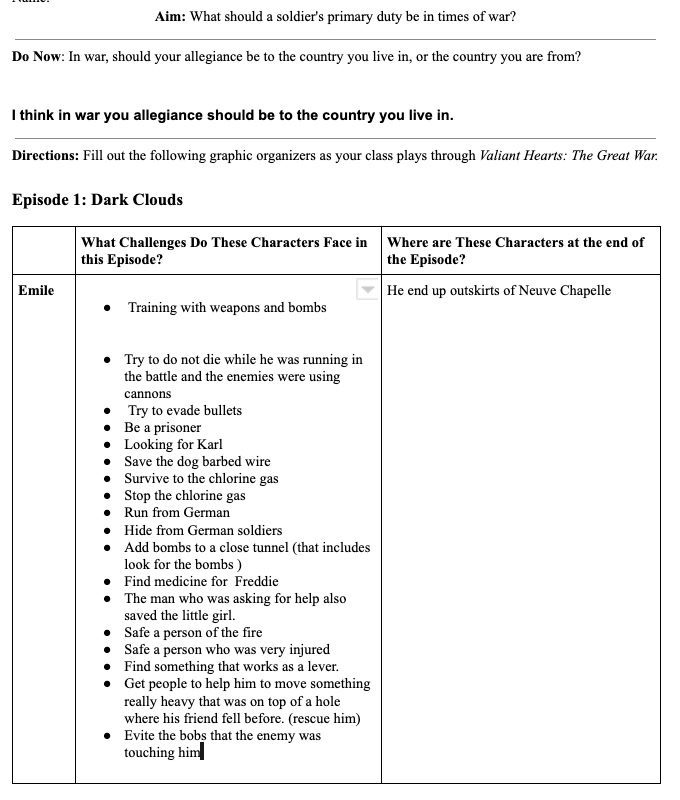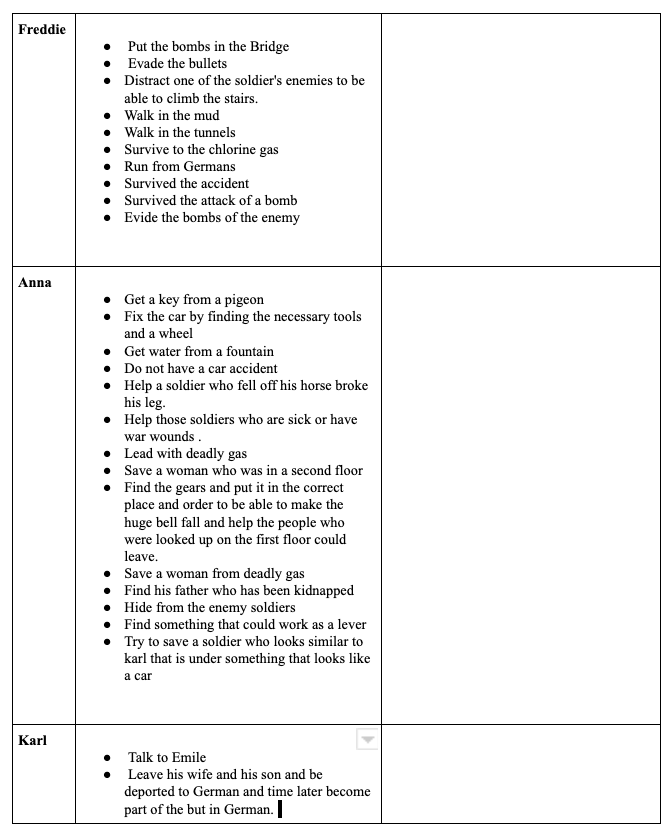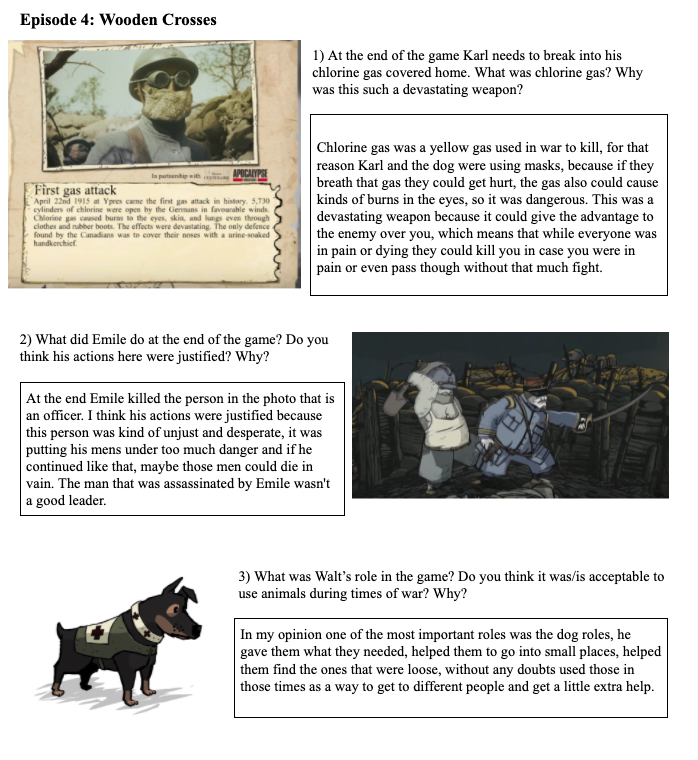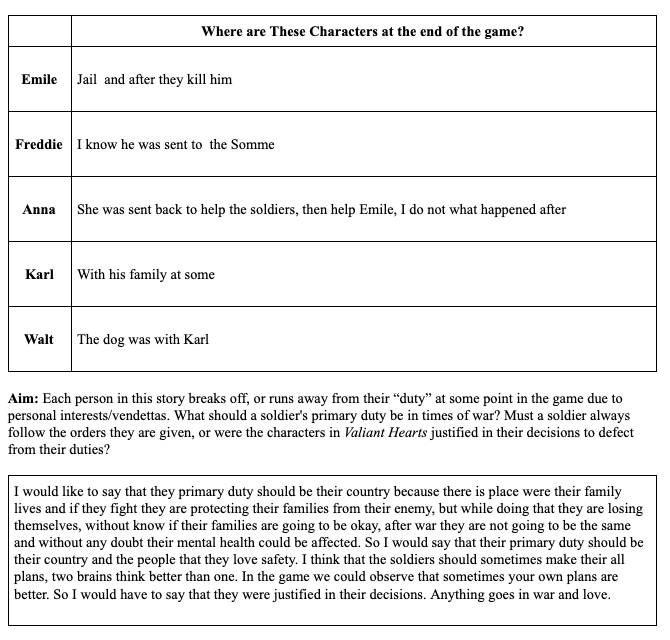I Taught With Valiant Hearts: The Great War
- Zack
- May 18, 2020
- 5 min read
Updated: Oct 26, 2020
What's going on everyone?
As we moved into remote learning about eight weeks ago, I wanted to make sure that I was still able to hold my video game literature class. While we can't all play together in class like we usually do, we can stream a game online and all watch together. One of my students knows how to stream, so I bought him a copy of Valiant Hearts: The Great War and had him stream it online (via Twitch) once a week over the course of four weeks. The rest of the class would watch the stream and partake in a chat where they can discuss with each other and watch together. You can find the lesson plan for Valiant Hearts: The Great War here.
There was no real reason for choosing Valiant Hearts other than some students expressing interest in learning about war and analyzing how war can be portrayed in video games. This is an elective course and I had an entirely different curriculum planned, but that all went out the window when we started remote learning. So we went with Valiant Hearts because I think it is a beautifully made game that is largely a historically accurate representation of World War I. The game was developed by Ubisoft and made in partnership with Mission Centenaire 14-18 and Apocalypse World War I. So while the game is historical fiction, it is filled with primary sources that add to the experience.

This image shows the basis of how we played together. We used the streaming website Twitch and had the rest of my class join and watch. Twitch has a chat box built into each stream so it was very easy for students to engage with one another as the student played. When he got stuck, which happened fairly often since the game incorporates many puzzles, the students were able to help out in the chat. It was also a place for me to bring in some of my knowledge about World War I. In this specific scene the students had asked me why there were blimps and not planes or helicopters.

The game is animated to look sort of like a comic book which helps it refrain from being too violent. We all understand what is happening on screen, but there is still a distance between between what is portrayed and what the war actually looked like. This makes it accessible for most young people. Luckily there are documents and artifacts scattered throughout the game as collectibles. Whenever you find one, there is a primary source document with a blurb attached to it. I would often have my student read these aloud as he collected them throughout the game. These resources add a sense of legitimacy to the game because the game is a cartoon and often silly.
The game is broken down into four episodes
Episode 1: Dark Clouds
For Episode one I didn't ask too much of them in terms of writing output. I wanted them to focus more on what is happening in the game because there are various plot threads and it can be a bit tricky to keep track of everyone. I started off by asking them who your loyalty should be to in times of war; the country you live in or the one you are from. The idea of loyalty is a theme found throughout the game. I asked them to write down some of the challenges faced by the characters throughout the episode. This student in particular took a lot more notes than I expected. She did not however answer the second question I asked for this episode. I wanted the students to note where each character is at the end of the episode. This student only responded for the first character. When I asked why she didn't add this info for the other characters she told me that she had already written a lot and was tired. That was fair enough for me.
Episode 2: Broken Earth

It is during the second episode of the game that we start learning about the different types of weapons and fighting that took place during the war. The focus is on trench warfare, a staple of World War I imagery. Anyone who has learned anything about the Great War knows how deadly and terrible trench warfare was. I believe the game does a decent job of conveying the hopelessness and death that enveloped the soldiers in those circumstances. For this episode I only asked them to tell me what they learned about trench warfare and provided a quick check for understanding question to make sure that they are keeping track of all the characters.
Episode 3: The Poppy Fields

I continued with some checking for understanding questions as we moved through the middle sections of the game. Questions throughout the final episode and after the game are much more analysis focused so I thought it would be okay to ask some simple questions just to make sure the students have a basic understanding of the characters and the plot. I asked them to tell me about the sole American character Freddie and about the Mark 1 Tank, which drastically altered the course of trench warfare. This student answered both questions, but left out that Freddie's wife had perished as a result of the war earlier. The death of his wife is what inspired him to join the French forces before the United States entered the war.
Episode 4: Wooden Crosses
The final episode touches on some of the more real consequences of World War I. This war introduced the world to the horrors of poison gas. This game specifically portrays the use of chlorine gas which killed over 90,000 soldiers throughout the war. The game also touches on something that I didn't expect the first time played it- Emile, one of the main characters of the game ends up killing his own officer. The officer was forcing his soldiers to continue into enemy territory and through the trenches regardless of how many people were being killed. The officer also threatened to kill anyone who refused. Emile, eventually unable to progress, kills the officer as a last resort to stay alive. He is eventually executed for this action. The students finished off by explaining where each character is at the end of the game and providing an analysis of what a soldier's duty should be in times of war. This student notes that while your duty should be to your country and loved ones, there may be times when you need to defect for the sake of your own safety and mental health.
Post Game Response

To end the unit, I had my students write a short response answering the following questions.
Why is the game in the style of a comic?
Why are every adult’s eyes covered?
Why the focus on puzzles instead of combat?
How come the characters never actually have dialogue?
I encourage everyone to read her response because I think it really shows how she understood the developer's intent for making this game. Please do note that my students are English Language Learners so their spelling and grammar will not be perfect.
Overall I would say that playing this game with my students was a success. They were mostly engaged throughout and mentioned that it was fun to still play games together even though everyone is stuck at home. If I can get my students to have fun and willingly log on each week to learn about something new, then I consider it worth our time.
Thanks for reading,
Zack
Consider subscribing if you would like to stay more up to date with posts like this. It's free!













I wanted more than a meeting…I wanted to feel something passionate. I felt an immediate chemical and electric connection that made for a truly real, exciting, and memorable evening. Escorts in Greater Noida || Karol Bagh Escorts Service || Mahipalpur Call Girls || Call Girls in Dwarka || Saket Escorts ||
Enjoy videos without ads and play in the background with YouTube Vanced. YouTube Vanced puts premium features in your hands for a smooth and customized experience.
Jun88 được biết đến như một nhà cái trực tuyến hàng đầu với giao diện hiện đại, dễ sử dụng. Người chơi tại https://jun88org.com/ có thể tham gia cá cược thể thao, game bài, nổ hũ và nhiều trò chơi hấp dẫn khác, mang đến trải nghiệm giải trí đẳng cấp quốc tế.
Lựa chọn https://jun88vu.com/ đồng nghĩa với việc bạn đang tham gia vào một sân chơi công bằng, minh bạch và đầy cơ hội. Với sự đồng hành của Jun88, mọi người chơi đều có thể tìm thấy niềm vui giải trí kết hợp cùng lợi ích tài chính hấp dẫn.
link vào sv388 là điểm đến hàng đầu cho những ai đam mê chọi kê trực tuyến. Với hệ thống live sắc nét, tốc độ ổn định và tỷ lệ trả thưởng cạnh tranh, nền tảng này mang đến trải nghiệm kịch tính và công bằng. Không chỉ nổi bật về chất lượng, SV388 còn thường xuyên tung ra nhiều ưu đãi hấp dẫn, thu hút đông đảo người chơi khắp châu Á lựa chọn tham gia mỗi ngày.